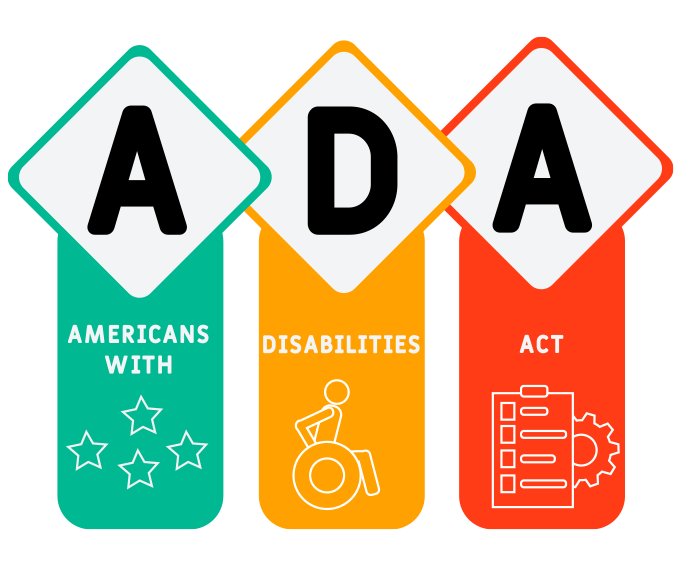In order to avoid a potential lawsuit, make sure your website is ADA compliant today!
Cases against small and medium size businesses are on the rise and the trend is expected to continue. Our proactive measure will help safeguard your business.
Signed into law in 1990, the Americans with Disabilities Act (ADA) ensures that people with disabilities are able to participate in mainstream American life. This is applicable to all public places and in recent years, it is also being applied to the world wide web.
Currently, the majority of web designers do not build websites to ADA standards. It’s expensive and time consuming as you must adhere to a checklist for each individual page of a website.

Previously, the primary targets of ADA website compliance lawsuits were governmental, educational, and financial institutions. But times are changing and small to mid-sized private sector businesses are being sued more frequently.
Don’t hesitate any longer! Start the process of making your website ADA compliant by contacting us today!

The Process to Become ADA Compliant
There is a long list of things that need to be done to make your website fully ADA compliant.
Since the ADA does not specifically address website accessibility, a group from within the World Wide Web Consortium (W3C) developed the Website Content Accessibility Guidelines (WCAG). The WCAG is often looked at as the authority on international standards for web accessibility. Adhering to them will not only make you ADA compliant; you will also meet compliance standards for several global requirements as well.
Federal agencies must adhere to WCAG, but private businesses don’t have the same requirement. However, their websites must still be accessible, can often fall under scrutiny, and are subject to lawsuits. The best way to ensure safety is to conform to the WCAG standards.
There are three main steps to make your website ADA compliant and avoid a potential legal issue.
-
Manual Remediation
: In order to make your website fully accessible, it has to be done manually—that is, at the code level and within page content. There is no quick fix, so be weary of any agency or software vendor that claims to have an instant solution. You may think you’re protected but you may still actually be at risk.
-
WAVE Check Errors
: Once remediations have been made, sites should be run through a website accessibility evaluation tool called WAVE. This free website checker scans your webpages for accessibility errors. It also happens to be the preferred method for identifying accessibility issues by legal counsel. Getting errors down to zero, or almost zero, is one of the best ways to avoid a legal issue.
-
Accessibility Policy
: Each website needs to have a custom website accessibility policy or statement. These statements specify the measures you’ve taken to ensure your website is accessible. It should include what you’ve done as well as what continual measures are in place to ensure it remains accessible. It is becoming commonplace for lawsuits to call out a lack of policy page, so it is more important now than ever to have such a page.
At Top Lead, our web accessibility/ADA compliance service takes care of all of these aspects for you. We dive in, web page by web page, manually adjusting all code and adding necessary elements. Then we ensure it is error free, and work with you to develop your ongoing policy. The combination of these efforts is the best way to ensure you avoid an ADA compliance lawsuit.
Ready to learn more or get started on your website compliance? Contact us now!

Standards and Best Practices for Website Accessibility
Although there is a newer version, the WCAG 2.0 is the current the go-to standard. WCAG 2.0 has a set of 61 testable success criteria to ensure your site is compliant at the highest level. There are three different levels of compliance ranging from A (lowest) to AAA (highest).
The newer version, WCAG 2.1 (released in 2018), added an additional 17 success criteria mostly dealing with accessibility on mobile devices and geared toward users with low vision or cognitive impairments.
While WCAG guidelines are highly specific, they are broken down into 4 main sections.
Perceivable
– Users must be able to perceive the information and components on the page.
Operable
– All user interface components and navigation must be operational.

Understandable
– Navigation, user interface, and content must be able to be reasonably understood.
Robust
– Content must be able to be read by a wide range of assistive technologies and other user agents.

How Domino’s Opened the Door for More Compliance Lawsuits
In October of 2019, the Supreme Court of the United States (SCOTUS) made a decision that has transformed the application of the Americans with Disabilities Act in the digital age.
A federal appellate court ruled that the plaintiff, a blind customer, was able to sue the pizza giant under the ADA because he couldn’t fully use their website with his screen-reading software. Domino’s argued that because the ADA was enacted prior to the modern internet, it should not apply.
Prior to the appeal to the SCOTUS, the Ninth Circuit Court of Appeals ruled that Domino’s must, as a place of public accommodation, make any visual materials capable of being interpreted by visually impaired customers. In their ruling, this extended to their apps and website regardless of the fact that neither are physically on the premises of a Domino’s location.
When the Supreme Court denied to hear the appeal, it effectively upheld the decision of the lower court, paving the way for similar lawsuits. ADA compliance lawsuits in the weeks following this decision spiked from prior weeks.
Although total cases in 2019 (2,235) were on par with 2018 (2,314),** this is likely due to the fact that many cases were on hold pending the Supreme Court decision. This decision has opened the door for similar cases and the number is expected to rise going forward.
**Source: UsableNet via


Who Is Most at Risk?
The industry most impacted by a wide margin is retail. Sixty percent of website compliance lawsuits in the United States in 2019 were in the retail space. Large retailers in particular were impacted, with over 66% of the Internet Retailer’s Top 500 being sued at least once since 2017. More than 40% of these had more than one lawsuit.
If you are sued, you must address it quickly as it is likely you will be sued again. In fact, in 2019, 21% of all companies sued were sued multiple times. The most targeted companies are those with multiple websites and/or multiple brands.
The next most impacted industry in 2019, coming in at 9% of all cases, was the food service industry. This is closely followed by entertainment/leisure and hospitality/tourism at 8% and 7%, respectively.
The percent of all cases continues to fall drastically from there, but nearly all industries are represented and have some number of cases.
Just because your industry is not one high in the rankings in 2019 does not mean you are in the clear. The number of lawsuits against private businesses is expected to continue to increase. The only way to avoid this headache is to act now!
Source: UsableNet via
How Do Disabled Individuals Access the Web?
The issue with accessibility is that your page must be available to people with a number of different types of disabilities. The way they access the web will depend on their specific condition. There is a great number of different assistive technology software and hardware that one may use to access your content.
Screen reader
– This software coverts visual content to other formats such as text-to-speech. These readers usually have various options for interacting with content and shortcuts that can be activated by speech and other means.
Refreshable Braille display
– Intended for the blind, this hardware attaches to a computer or other device and displays a line of Braille as the user reads along. As the name implies, it refreshes to reflect each new line as they move through the content.

Eye tracking
– These devices monitor eye movement and blinks to move through content and initiate mouse clicks.
Head pointers
– Users without use of their hands and other parts of their body benefit from this device which is attached directly to their head. Through different types of motion, they can interact with various types of web content.
Accelerators
– Reducing the need or effort required to type or click, this software option allows for programmable shortcuts of commands or sequences of commands. They can also help to select items and steer a mouse.
This is just a small sample of the devices and methods that those with disabilities may use to perceive and interpret your content. With so many different forms of disabilities and the sheer number of different assistive technologies, it’s easy to understand why making your website accessible to all can be a tall order. It also sheds light on why it must be done manually to ensure every necessary element is addressed.
Unfortunately, becoming ADA compliant does not have an easy or quick fix. The good news is that we can take the stress off. Our reliable and thorough service can give you peace of mind that you meet the necessary guidelines. We’re ready to get started on your page today. Contact us to learn more!
Benefits of Being Compliant
Making your website ADA complaint isn’t just a legal matter, it’s also the right thing to do and it’s good for business.
Legal Protection
– With the number of compliance lawsuits on the rise, it is imperative to act proactively to avoid a costly and time-consuming remediation in response to a lawsuit.
Brand Reputation
– More and more, consumers are concerned with purchasing from companies they feel good about. One of the best ways to make your brand one to feel good about is by making your business inclusive of all. That absolutely includes your website and online presence.
Reaching More Customers
– Perhaps the strongest reasoning for compliance is the number of new users that will be able to visit and interpret your website. In the adult population of the United States alone, 11% have a cognitive disability, 6% have a hearing disability, and 5% have a visual disability.* Making your website accessible immediately increases your potential customer pool.
*Source: CDC
Source Websites:
NOTE FROM SITE!!: Data and images can be shared when referencing UsableNet as a source and linked to our Website.

